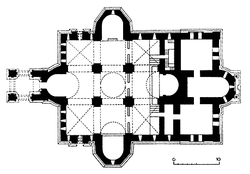
Back عمارة الكنائس Arabic Arquitectura de iglesias Spanish معماری کلیسا Persian Kirkkoarkkitehtuuri Finnish Architecture ecclésiastique French אדריכלות כנסיות HE Crkveno graditeljstvo Croatian Keresztény templomépítészet Hungarian Arsitektur Gereja ID 교회 건축 Korean
Top: Etchmiadzin cathedral plan; Arches of the Hagia Sophia sketch; Centre: Saint Peter's Basilica; Bottom: Saint Paul's Cathedral nave |

Church architecture refers to the architecture of Christian buildings, such as churches, chapels, convents, seminaries, etc. It has evolved over the two thousand years of the Christian religion, partly by innovation and partly by borrowing other architectural styles as well as responding to changing beliefs, practices and local traditions. From the Early Christianity to the present, the most significant objects of transformation for Christian architecture and design were the great churches of Byzantium, the Romanesque abbey churches, Gothic cathedrals and Renaissance basilicas with its emphasis on harmony. These large, often ornate and architecturally prestigious buildings were dominant features of the towns and countryside in which they stood. However, far more numerous were the parish churches in Christendom, the focus of Christian devotion in every town and village. While a few are counted as sublime works of architecture to equal the great cathedrals and churches, the majority developed along simpler lines, showing great regional diversity and often demonstrating local vernacular technology and decoration.
Buildings were at first from those originally intended for other purposes but, with the rise of distinctively ecclesiastical architecture, church buildings came to influence secular ones which have often imitated religious architecture. In the 20th century, the use of new materials, such as steel and concrete, has had an effect upon the design of churches.
The history of church architecture divides itself into periods, and into countries or regions and by religious affiliation. The matter is complicated by the fact that buildings put up for one purpose may have been re-used for another, that new building techniques may permit changes in style and size, that changes in liturgical practice may result in the alteration of existing buildings and that a building built by one religious group may be used by a successor group with different purposes.



